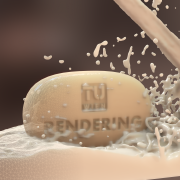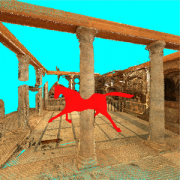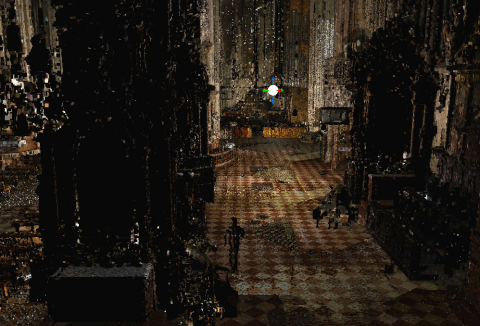- Austrian Academy of Sciences (ÖAW): Norbert Zimmermann
- Imagination Computer Services GmbH
Laser scanning is an important tool in cultural heritage for documenting the state of archaeological monuments. The data produced by laser scanning is ever increasing, with the latest generation of laser scanners generating a billion of points in one measurement pass. To colorize the laser scans, additional photographs are taken. Managing these huge amounts of data in terms of size is a challenge on its own, but also to ensure the quality of the resulting point-based models is of utmost importance for the further development of laser scanning as a standard technique in cultural heritage. We identified three topics that can drive forward the integration of laser scanning in the everyday work of archaeologists.
The first topic is the recoloring of point clouds that are combined from several different scan positions. The photographs taken at the different scan positions all exhibit different colorizations of the objects in the scene, as the lighting conditions usually vary from scan position to scan position. We want to develop methods that can provide an artifact free colorized model, independent of the lighting conditions that prevailed during laser scanning. The second topic deals with the management of large point clouds. It incorporates compression of the point cloud data, where the data shall nevertheless remain editable, and the display of large data. Several compression techniques for different point attributes, lossless as well as lossy compression, and fitting points to higher order primitives will be used for compression depending on the further use of the data. To display the data, an eye-tracker can be used to increase the visual experience of the user. The third topic deals with the distribution of data over a network, and navigating through the data, so that users can get access to large point-based models of cultural heritage sites with intuitive navigation capabilities.
Cultural Heritage is a growing market that needs intensive support from enabling technologies like real-time computer graphics and 3D object reconstruction. Especially the preservation and presentation of archaeological or historical items (architecture, artifacts) are of high importance there. Austria is well known in the tourism industry because of its cultural values. Preserving and presenting such cultural values not only physically but also in digital form, will help to distribute these values also using new media channels to the broad public. Any improvement of the technology that helps to preserve cultural items and allows presenting such items and scientific findings to a large audience will improve the value of these cultural items and in the same way boost the tourism industry.
Especially in Austria there is a huge "creative industries" community, small and medium companies working on innovative presentations of cultural goods. Especially these companies will profit from the technology that will be developed in this project. One of these "creative industries" companies is Imagination, partner in this project and pioneer in cultural heritage presentations and preservation software.
Funding
- FFG 825842
Research Areas
- In this area, we concentrate on algorithms that synthesize images to depict 3D models or scenes, often by simulating or approximating the physics of light.
- Uses concepts from applied mathematics and computer science to design efficient algorithms for the reconstruction, analysis, manipulation, simulation and transmission of complex 3D models. Example applications are collision detection, reconstruction, compression, occlusion-aware surface handling and improved sampling conditions.
Publications
| Image | Bib Reference | Publication Type |
|---|---|---|
| 2018 | ||
 |
Sebastian Mazza Optimized Sorting for Out-of-Core Surface Reconstruction [  thesis] thesis] |
Bachelor Thesis |
| 2017 | ||
Claus Scheiblauer, Norbert Zimmermann, Michael Wimmer Workflow for Creating and Rendering Huge Point Models In Fundamentals of Virtual Archaeology: Theory and Practice, 2017 |
Article in a Book | |
| 2014 | ||
 |
Markus Tragust Integrating Annotations into a Point-based Rendering System [  thesis] thesis] |
Master Thesis |
 |
Claus Scheiblauer Interactions with Gigantic Point Clouds Supervisor: Michael Wimmer  Duration: December 2006 — July 2014 [  thesis] thesis] |
PhD-Thesis |
| 2013 | ||
 |
Kurt Leimer External Sorting of Point Clouds [  thesis] thesis] |
Bachelor Thesis |
 |
Claus Scheiblauer, Michael Wimmer Analysis of Interactive Editing Operations for Out-of-Core Point-Cloud Hierarchies In WSCG 2013 Full Paper Proceedings, pages 123-132. June 2013. [  paper] paper] |
Conference Paper |
 |
Murat Arikan, Michael Schwärzler, Simon Flöry, Michael Wimmer , Stefan Maierhofer , Stefan MaierhoferO-Snap: Optimization-Based Snapping for Modeling Architecture ACM Transactions on Graphics, 32(1):6:1-6:15, January 2013. [  draft] draft] |
Journal Paper with Conference Talk |
| 2012 | ||
 |
Claus Scheiblauer, Michael Wimmer Graph-based Guidance in Huge Point Clouds In Proceedings of the 17th International Conference on Cultural Heritage and New Technologies. November 2012. [  paper] [ paper] [ |
Conference Paper |
 |
Reinhold Preiner , Stefan Jeschke, Michael Wimmer , Stefan Jeschke, Michael Wimmer Auto Splats: Dynamic Point Cloud Visualization on the GPU In Proceedings of Eurographics Symposium on Parallel Graphics and Visualization, pages 139-148. May 2012. [  draft] draft] |
Conference Paper |
 |
Reinhold Preiner , Michael Wimmer , Michael Wimmer Interactive Screen-Space Triangulation for High-Quality Rendering of Point Clouds TR-186-2-12-01, April 2012 [  tech-report] tech-report] |
Technical Report |
| Stefan Trumpf Labeling and Leveling of Meshes |
Student Project | |
| Markus Tragust Graph Models for Guided Point Cloud Navigation |
Student Project | |
| 2011 | ||
 |
Claus Scheiblauer, Michael Pregesbauer Consolidated Visualization of Enormous 3D Scan Point Clouds with Scanopy In Proceedings of the 16th International Conference on Cultural Heritage and New Technologies, pages 242-247. November 2011. [  paper] paper] |
Conference Paper |
 |
Irmengard Mayer, Claus Scheiblauer, Albert Julian Mayer Virtual Texturing in the Documentation of Cultural Heritage Geoinformatics FCE CTU, 7, September 2011. [  paper draft] paper draft] |
Journal Paper with Conference Talk |
 |
Reinhold Preiner Screen-Space Triangulation for Interactive Point Rendering, 6. June 2011, Austrian-Russian Joint Seminar, Vienna [  slides] slides] |
WorkshopTalk |
 |
Claus Scheiblauer, Michael Wimmer Out-of-Core Selection and Editing of Huge Point Clouds Computers & Graphics, 35(2):342-351, April 2011. [  paper] paper] |
Journal Paper (without talk) |
 |
Stefan Marek Normal Estimation of Very Large Point Clouds [  poster] [ poster] [ thesis] thesis] |
Master Thesis |
 |
Gabriele Hebart Color Adjustment of Colored Range Images [  poster] [ poster] [ thesis] thesis] |
Master Thesis |
| 2010 | ||
 |
Albert Julian Mayer Virtual Texturing [  poster] [ poster] [ Thesis] Thesis] |
Master Thesis |
| Michael Probst, Jakub Kolesik GPU Point Cloud Raytracing |
Student Project | |


